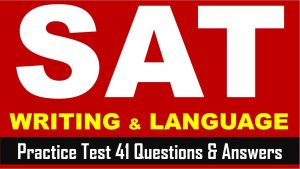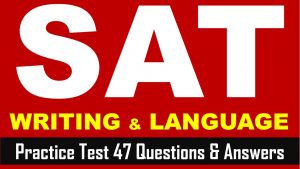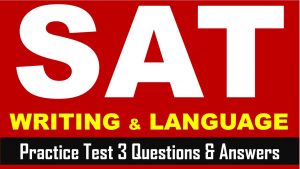Hi SAT Aspirants, welcome to AKVTutorials. As you know SAT (Scholastic Assessment Test) is a standard test, used for taking admission to undergraduate programs of universities or colleges of United States. SAT is developed and published by the College Board, an organization in United States, administered by the Educational Testing Service. Therefore, you need to do practice on SAT Reading Section, SAT Writing and Language Section. In this article, you will get SAT Writing Practice Questions Paper 65 with Answer Keys AMBIPi
Instruction:
- In the passage below is accompanied by a number of questions.
- For some questions, you need to think how the passage might be revised to improve the expression of ideas.
- For other questions, you will consider how the passage might be edited to correct errors in sentence structure, usage, or punctuation.
- Some questions will direct you to an underlined portion of a passage.
- Other questions will direct you to a location in a passage or ask you to think about the passage as a whole.
SAT Writing & Language Section Passage
SAT Writing Practice Questions Paper Passage Title: A work in Progress: Te Periodic Table
1 How long does it take to write a chemistry textbook? Now a ubiquitous sight in chemistry classrooms everywhere, 2 the conception of this orderly arrangement of the elements was due to the nineteenth-century Russian chemist Dmitri Mendeleev while he was writing a textbook on general chemistry. The basic 3 principle of Mendeleev’s periodic order of elements have remained the same, even as it has grown in size. This key development in the history of science still defines our contemporary understanding 4 of matter in today’s times.
[1] Like many scientific breakthroughs, 5 Mendeleev was partially anticipated by the work of other scientists. [2] For example, the French geologist Alexandre-Emile Béguyer de Chancourtois is generally credited with discovering periodicity—the existence of recurring trends across 6 elements- in 1862. [3] Another key observation was made the following year by the British scientist John Newlands, who noted that similar elements were often related in mass by a multiple of eight. [4] By Mendeleev’s own account, de Chancourtois and Newlands were among those “foremost” in research that led to the discovery of this law. 7
While not the first scientist to attempt a comprehensive organization of the elements, Mendeleev did publish a paper in 1869 with the first draft of the modern periodic table. In this table, families of elements were arranged horizontally; however, Mendeleev eventually revised this Format to the vertical structure found in contemporary chemistry textbooks.
8 Based on the patterns he observed, Mendeleev suggested that the properties of elements are a reflection of their atomic weight. Also based on these patterns, Mendeleev made concrete predictions about elements that had yet to be discovered. For instance, Mendeleev predicted the discovery of two elements analogous to aluminum and silicon; these were later discovered to be gallium and germanium. 9 This predictive power became one of the defining characteristics of the periodic table.
The periodic table proposed by Mendeleev was the culmination of many observations and discoveries— 10 unfortunately, many of his peers were reluctant to accept his ideas. From electronegativity to electron orbitals, the periodic table 11 anticipating many future topics of scientific inquiry. Even today, scientists use the predictive power of the periodic table to generate new hypotheses and design experiments that further expand our understanding of the universe.
SAT Writing Practice Questions Paper
Question No 1
Which choice best maintains the sentence pattern already established in the paragraph?
Option A : No Change
Option B : Which elements in the periodic table are the most important?
Option C : What important discoveries were made by Russian scientists?
Option D : Where did the modern periodic table come from?
Answer
Show/Hide Answer
Option D : Where did the modern periodic table come from?
Question No 2
Which of the following options is the most effective?
Option A : No Change
Option B : Dmitri Mendeleev, a nineteenth-century Russia
Option C : the nineteenth-century Russian chemist Dmitri Mendeleev conceived this orderly arrangement of the elements
Option D : this orderly arrangement of the elements was Conceived by the nineteenth-century Russian chemist Dmitri Mendeleev
Answer
Show/Hide Answer
Option D : this orderly arrangement of the elements was Conceived by the nineteenth-century Russian chemist Dmitri Mendeleev
Question No 3
Which choice provides the most effectively transition to the information that follows?
Option A : No Change
Option B : principles
Option C : principals
Option D : principal
Answer
Show/Hide Answer
Option B : principles
Question No 4
Which choice results in the most effective transition to the information that follows in the paragraph?
Option A : No Change
Option B : and how we think about matter in today’s times.
Option C : of matter.
Option D : and how we think about matter.
Answer
Show/Hide Answer
Option C : of matter.
Question No 5
Which choice best maintains the sentence pattern already established in the paragraph?
Option A : No Change
Option B : Mendeleev’s periodic table
Option C : this
Option D : it
Answer
Show/Hide Answer
Option B : Mendeleev’s periodic table
Question No 6
Which choice best maintains the sentence pattern already established in the paragraph?
Option A : No Change
Option B : elements,
Option C : elements;
Option D : elements
Answer
Show/Hide Answer
Option A : No Change
Question No 7
The writer wants to add the following sentence to the paragraph. This mathematical relationship, named the “Law of Octaves” by Newlands, would later be defined as the ‘periodic law.’ The best placement for the sentence is after
Option A : sentence 1.
Option B : sentence 2.
Option C : sentence 3.
Option D : sentence 4.
Answer
Show/Hide Answer
Option C : sentence 3.
Question No 8
Which choice most effectively combines the underlined sentences?
Option A : Mendeleev made concrete predictions about elements that had yet to be discovered, and before this he even suggested, based on the patterns he observed, that properties of elements are a reflection of their atomic weight.
Option B : Based on the patterns he observed, Mendeleev not only suggested that the properties of elements are a reflection of their atomic weight, but he also made concrete predictions about elements that had yet to be discovered.
Option C : Mendeleev made concrete predictions, based on the patterns he observed, about elements that had yet to be discovered, although he also suggested that the properties of elements are a reflection of their atomic weight.
Option D : Elements that had yet to be discovered, according to Mendeleev, could be predicted concretely, and he also suggested that the properties of elements are a reflection of their atomic weight, based on the patterns he observed.
Answer
Show/Hide Answer
Option B : Based on the patterns he observed, Mendeleev not only suggested that the properties of elements are a reflection of their atomic weight, but he also made concrete predictions about elements that had yet to be discovered.
Question No 9
The writer is considering deleting the underlined sentence. Should the sentence be kept or deleted?
Option A : Kept, because it effectively concludes the paragraph by tying the discussion back to the passage’s focus on the periodic table.
Option B : Kept, because it provides evidence to support the argument that Mendeleev’s periodic table was anticipated by the work of previous scientists.
Option C : Deleted, because it unnecessarily repeats evidence about the the specific elements which Mendeleev predicted.
Option D : Deleted, because it blurs the paragraph’s focus on the predictions Mendeleev made about the discovery of future elements.
Answer
Show/Hide Answer
Option A : Kept, because it effectively concludes the paragraph by tying the discussion back to the passage’s focus on the periodic table.
Question No 10
Which choice best maintains the sentence pattern already established in the paragraph?
Option A : No Change
Option B : however, the accomplishments of his predecessors are not always acknowledged.
Option C : the mathematical order of the universe was central to his success.
Option D : but, like every culmination, this end was also a beginning.
Answer
Show/Hide Answer
Option D : but, like every culmination, this end was also a beginning.
Question No 11
Which choice completes the sentence with accurate data based on the graph?
Option A : No Change
Option B : anticipated
Option C : that anticipated
Option D : that anticipating
Answer
Show/Hide Answer
Option B : anticipated



